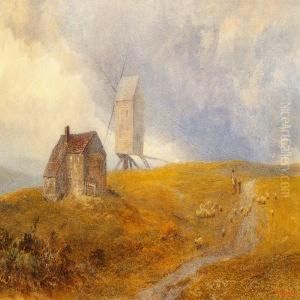H.G. Hine Paintings
Henry George Hine, often referred to as H.G. Hine, was a notable English artist born on June 25, 1811, in Brighton, England. He was primarily known for his watercolor landscapes that beautifully captured the essence of the English countryside, as well as scenes from his travels abroad. His work is characterized by its delicate use of color and the ability to convey atmospheric effects, which made him a significant member of the English watercolor tradition in the 19th century.
Hine was apprenticed to an architect in his early years, which had a lasting influence on his artistic career. This background in architecture informed his approach to composition and perspective in his landscape paintings. Despite his initial career path, Hine's passion for art prevailed, and he began pursuing painting more seriously. He became a member of the New Watercolour Society, which later became the Royal Institute of Painters in Water Colours, where he exhibited regularly and gained considerable recognition for his work.
Throughout his life, H.G. Hine was an active member of the artistic community. He lived and worked in London for most of his career, where he found inspiration in the Thames and the city's surrounding areas. Hine also traveled extensively throughout Britain and Europe, sketching and painting landscapes that reflected his keen observation of natural phenomena and the changing qualities of light. His travels took him to picturesque locations in France, Italy, and Switzerland, among others, where he captured the local scenery with his brush.
Hine's contribution to the art world was not just limited to his own creations; he was also an influential figure among his peers and served as a tutor to aspiring artists. He shared his knowledge and passion for watercolor painting, thereby helping to shape the next generation of landscape artists.
Henry George Hine passed away on September 13, 1895, leaving behind a legacy of beautiful landscapes that continue to be appreciated for their lyrical quality and their embodiment of the 19th-century English watercolor tradition. His works are held in various collections, including those of public institutions and museums, where they serve as a testament to his skill and artistic vision.
